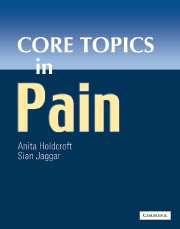Book contents
- Frontmatter
- Contents
- Contributors
- Preface
- Acknowledgements
- Foreword
- General abbreviations
- Basic science abbreviations
- PART 1 BASIC SCIENCE
- PART 2 PAIN ASSESSMENT
- Section 2a Pain measurement
- Section 2b Diagnostic strategies
- PART 3 PAIN IN THE CLINICAL SETTING
- Section 3a Clinical presentations
- Section 3b Pain syndromes
- PART 4 THE ROLE OF EVIDENCE IN PAIN MANAGEMENT
- PART 5 TREATMENT OF PAIN
- Section 5a General Principles
- Section 5b Physical treatments
- Section 5c Pharmacology
- 39 Routes, formulations and drug combinations
- 40 Opioids and codeine
- 41 Non-steroidal anti-inflammatory agents
- 42 Antidepressants, anticonvulsants, local anaesthetics, antiarrhythmics and calcium channel antagonists
- 43 Cannabinoids and other agents
- Section 5d Psychosocial
- PART 6 SUMMARIES
- Glossary
- Index
43 - Cannabinoids and other agents
from Section 5c - Pharmacology
Published online by Cambridge University Press: 10 December 2009
- Frontmatter
- Contents
- Contributors
- Preface
- Acknowledgements
- Foreword
- General abbreviations
- Basic science abbreviations
- PART 1 BASIC SCIENCE
- PART 2 PAIN ASSESSMENT
- Section 2a Pain measurement
- Section 2b Diagnostic strategies
- PART 3 PAIN IN THE CLINICAL SETTING
- Section 3a Clinical presentations
- Section 3b Pain syndromes
- PART 4 THE ROLE OF EVIDENCE IN PAIN MANAGEMENT
- PART 5 TREATMENT OF PAIN
- Section 5a General Principles
- Section 5b Physical treatments
- Section 5c Pharmacology
- 39 Routes, formulations and drug combinations
- 40 Opioids and codeine
- 41 Non-steroidal anti-inflammatory agents
- 42 Antidepressants, anticonvulsants, local anaesthetics, antiarrhythmics and calcium channel antagonists
- 43 Cannabinoids and other agents
- Section 5d Psychosocial
- PART 6 SUMMARIES
- Glossary
- Index
Summary
The treatment of pain has changed over the years from a disease- and site-based therapy to a mechanistic approach. The multiple mechanisms for pain sensation to be modified peripherally and in the central nervous system (CNS) provide many avenues for drug targets. This chapter aims to describe the variety of agents not covered elsewhere in this text.
α2 adrenoreceptor agonists
These agents have a long history in veterinary practice, where they have been used to provide local analgesia and sedation in a wide range of animals. Their role in human pain relief is now established.
Mechanism of action
Four subtypes of the G protein-linked α2 adrenoreceptors have been described. The α2A subtype that appears to be associated with analgesia and sedation is encoded on chromosome 10. These receptors have been localised to:
Brain and brainstem: specifically in the locus coeruleus, where stimulation is associated with activation of the descending inhibitory noradrenergic pathways.
The spinal cord: particularly in the substantia gelatinosa, where activation is able to inhibit firing of nociceptive neurones.
Peripheral neurone terminals (both peripheral and central).
Stimulation of receptors at any of these sites is associated with membrane hyper-polarisation and subsequent inhibition of activity (Chapter 8).
Interaction between opioid and α2 adrenoreceptor activity has been explored in μ opioid (MOP) receptor knock out mice.
- Type
- Chapter
- Information
- Core Topics in Pain , pp. 287 - 290Publisher: Cambridge University PressPrint publication year: 2005



